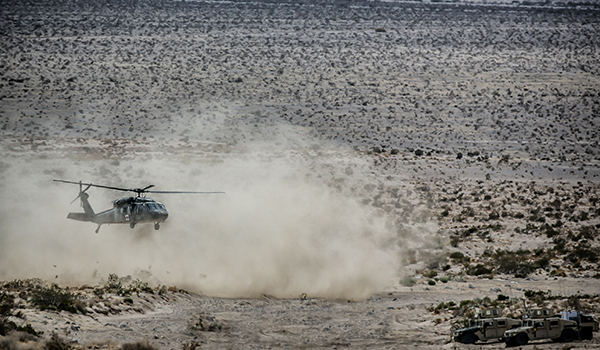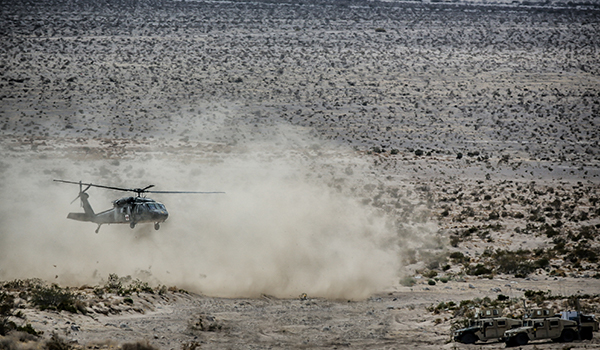
By CW5 Joseph B. Roland and MAJ Eric Megerdoomian: Over the last 19 years, we have seen Army Aviation focus on materiel, doctrinal, and training solutions to better support Wide Area Security (WAS) or the Counter Insurgency (COIN) operations in Iraq and Afghanistan.

An HH-60 Black Hawk MEDEVAC aircraft from 1st Air Cavalry Brigade executes a patient transfer from a Role I facility during NTC Rotation 17-01. Despite avoiding the risk of point of injury (POI) missions, MEDEVAC are required to utilize terrain to mask their movements in the DATE environment. / PERSONAL PHOTO BY MAJ ERIC MEGERDOOMIAN
Imges of Iraq and Afghanistan required Army Aviation to adapt and we did so with tremendous success. Unfortunately, our ability to solely support WAS operations is not enough. Many of the skills and tactics we gained proficiency and competence in over the last 15 years will no longer be enough to defeat a near peer threat. We have atrophied our ability to execute combined arms maneuver (CAM) in support of brigade combat teams (BCTs) and divisions (DIVs) against a peer threat during large scale combat operations (LSCO). Our training strategy must focus on gaining and maintaining proficiency in our Aviation core competencies and the application of Army Warfighting doctrine.
This article will highlight just three of the initiatives USAACE is working on in an effort to increase the warfighting proficiency necessary in LSCO. These initiatives include: the Aviation War-Fighting Initiative (AWI), the Terrain Flight Training Support Package (TSP), and the refinements to Army Aviation doctrine.
Aviation War Fighting Initiative (AWI)
During our Directorate of Evaluation and Standardization (DES) unit assessments, we are finding that rated and non-rated crewmembers are often more knowledgeable about trivial subjects than the application of war-fighting skills and doctrine. The ability to draw the inner workings of a night vision goggle (NVG) tube, the ability to recite the acronym NORMA, and the ability to write the lift equation are some notable examples of trivial information (particularly to the junior aviator). These examples do not directly correlate to increased lethality and survivability when fighting a peer threat. The recently published STACOM 18-03 provides greater fidelity on the upcoming changes to TC 3-04.11 and the Aircrew Catalogue of Academic Topics (ACAT) within the dATMs to be published soon. In essence, STACOM 18-03 provides the guidance necessary for units to start training and evaluating tasks in a tactical environment that are directly linked to increase lethality and survivability on the battlefield.
Terrain Flight Training Support Package
The advent of advanced aircraft survivability equipment (ASE) and the modernization of our sights and sensors have enabled our branch to mitigate enemy threats and terrain flight hazards with altitude for over a decade. As a result, we have mitigated risk successfully in the WAS fight, but have atrophied our ability to operate in terrain flight profiles necessary to survive in the DA environment. LSCO against a peer threat in a radar environment will force us to utilize terrain to mask our movements and in order to enable maneuver. Our ability to deliberately train our crews individually and collectively, utilizing a gated training strategy, is critical to increasing proficiency and mitigating risk. DES is currently developing a Terrain Flight Training Support Package (TSP) that will offer off-the-shelf assistance for war-fighting units to minimize the conceptual burden on units while we increase our proficiency at terrain flight altitudes.
Doctrinal Adjustments
Lastly, USAACE is in the process of adjusting, revising, and refining our doctrine in order to increase the lethality of our war-fighting units. TC 3-04.11 will support the AWI by focusing training and evaluations towards the tactical environment. TC 3-04.3 will replace the current Combat Aviation Gunnery manual, reduce restrictions, and provide greater flexibility for commanders to train their formations. While remaining nested under FM 3-0 and FM 3-04, ATP 3-04.1 will address core competencies of Army Aviation, but will be written primarily for our Platoon and Company level leaders. Key changes to ATP 3-04.1 will include greater use of processes to guide leaders through the operations process (Plan, Prepare, Execute, and Assess) methodology while reinvigorating the considerations of all the War Fighting Functions (Mission Command, Movement and Maneuver, Fires, Intelligence, Sustainment, and Protection). To supplement doctrine, USAACE has developed the Aviator Handbook and will soon publish an Army Aviation Standardization, Aviation Maintenance/ Sustainment, and Aviation Planning SOPs.
The FORSCOM CG recently stated during the senior leader’s conference: “Commanders, it is in your laps to prepare and train your organizations. It’s on you and you alone to ensure they are ready to fight tonight.” It is imperative that units start to train purposefully for the next fight now. Combat training centers (CTC) today are similar in nature to the CTCs of the 90s. They provide the tough realistic training in austere environments that will challenge the systems we develop and employ in the DA fight. Units must establish and utilize a gated training strategy to increase complexity from the individual through collective training and leader validation prior to arriving at CTCs. Units must also train their staff to execute the operations and the military decision-making process to ensure all war-fighting functions (not just movement and maneuver) are addressed, incorporated and synchronized during the projection of aviation combat power. All of this must be done in austere environments in order to build the necessary field craft to remain agile and survivable during the next conflict.
“Above the Best!”










